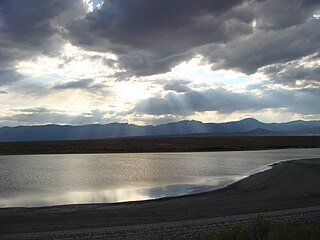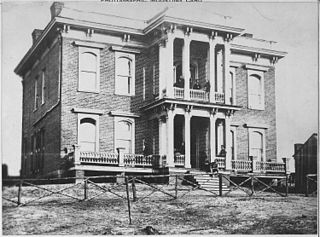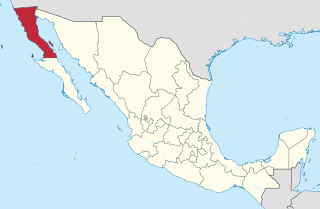
George Karl Ludwig Preuss (1803–1854), anglicized as Charles Preuss, was a surveyor and cartographer who accompanied John C. Fremont on his exploratory expeditions of the American west, including the expedition where he and Fremont were the first to record seeing Lake Tahoe from a mountaintop vantage point as they traversed what is now Carson Pass in February 1844. He participated in expeditions until he reached the age of 50. One year later, in 1854, he committed suicide.

The U.S. Army Corps of Topographical Engineers, authorized on 4 July 1838, consisted only of officers and was used for mapping and the design and construction of federal civil works such as lighthouses and other coastal fortifications and navigational routes. It included such officers as George Meade, John C. Frémont and Stephen Long. It was merged with the United States Army Corps of Engineers on 31 March 1863, at which point the Corps of Engineers also assumed the Lakes Survey District mission for the Great Lakes. In the mid-19th century, Corps of Engineers' officers ran Lighthouse Districts in tandem with U.S. Naval officers.

Aubrey Landing, Aubrey City or Aubrey is a ghost town at the mouth of the Bill Williams River in southern Mohave County, Arizona. The town was founded before 1865 and was abandoned sometime after 1886. Aubrey Landing was inundated when Lake Havasu was formed.

Frederick Wilhelm von Egloffstein was a German-born military man, explorer, mapmaker, landscape artist and engraver. He was the first person to employ ruled glass screens, together with photography, to produce engravings.

Port Isabel was a seaport established on Port Isabel Slough in 1865 during the American Civil War in Sonora, Mexico in the mouth of the Colorado River on the Gulf of California. It was founded to support the increased river traffic caused by the gold rush that began in 1862 on the Colorado River and the Yuma Quartermaster Depot newly established in 1864 to support the Army posts in the Arizona Military District. The slough was discovered in 1865 by the Captain W. H. Pierson of the schooner Isabel, that first used the slough to transfer its cargo to steamboats safe from the tidal bore of the Colorado River. Shortly afterward Port Isabel was established 3 miles up the slough and replaced Robinson's Landing as the place where cargo was unloaded in the river from seagoing craft on to flat bottomed steamboats of the Colorado River and carried up to Fort Yuma and points further north on the river.
Joseph Christmas Ives was an American soldier, botanist, and an explorer of the Colorado River in 1858.

Steamboats on the Colorado River operated from the river mouth at the Colorado River Delta on the Gulf of California in Mexico, up to the Virgin River on the Lower Colorado River Valley in the Southwestern United States from 1852 until 1909, when the construction of the Laguna Dam was completed. The shallow draft paddle steamers were found to be the most economical way to ship goods between the Pacific Ocean ports and settlements and mines along the lower river, putting in at landings in Sonora state, Baja California Territory, California state, Arizona Territory, New Mexico Territory, and Nevada state. They remained the primary means of transportation of freight until the advent of the more economical railroads began cutting away at their business from 1878 when the first line entered Arizona Territory.
Pedrick's was a steamboat landing, owned by John Pedrick, supplying wood to the steamboats on the lower Colorado River in Sonora, Mexico, from the mid 1850s to the late 1870s. After the 1854 Gadsden Purchase, Pedrick's was within New Mexico Territory and Arizona Territory after 1863. Pedrick's landing was located 24 miles above Ogden's Landing and 31 miles below Fort Yuma. Pedrick's lay along the east bank of the river just above what is now the Sonora - Arizona border in modern Yuma County, Arizona.
Ogden's Landing was a steamboat landing and woodyard, owned by former ferry partner of George Alonzo Johnson, supplying wood to the steamboats on the lower Colorado River in Sonora, Mexico, from the mid 1854 to the late 1870s. Ogden's Landing was located 28 miles above Gridiron and 24 miles below Pedrick's. Ogden's Landing lay along the east bank of the river 19 miles below what is now the Sonora - Arizona border.
Gridiron was a steamboat landing and woodyard on the lower Colorado River in Sonora state of northwestern Mexico,.
Port Famine was a steamboat landing and woodyard, supplying wood to the steamboats on the lower Colorado River in Sonora, Mexico, from the 1854 to the late 1870s. Port Famine was located 40 miles above Robinson's Landing and 17 miles below Gridiron. Port Famine lay along the east bank of the river 64 miles below what is now the Sonora - Arizona border.
Explorer was a small custom made stern-wheel steamboat built for Second lieutenant Joseph Christmas Ives and used by him to carry the U. S. Army Corps of Topographical Engineers expedition to explore the Colorado River above Fort Yuma in 1858.
Eureka or Eureka Landing, is a former mining town and steamboat landing, now a ghost town, on the Arizona bank of the Colorado River in what is now La Paz County, Arizona. It was originally located in Yuma County, Arizona from 1863 through the 1870s.
Williamsport is a former mining town and present day ghost town, on the bank of the Colorado River in La Paz County, Arizona.
Drift Desert is a former ranch and steamboat landing on the Colorado River, now a ghost town, in La Paz County, Arizona.

Fortification Rock, once a landmark hill on the Colorado River before it was inundated, now known as Rock Island, southernmost and tallest of the Boulder Islands in Lake Mead, Clark County, Nevada. It has an elevation of 1284 feet. Fortification Rock appears on the 1861 Geological Map No. 1; Rio Colorado of the West, explored by 1st Lieut. Joseph C. Ives, which shows Fortification Rock, Ives Camp #59 and the course of the Colorado River from its mouth on the Gulf of California to Las Vegas Wash and the location of its features and other expedition camps along the way.

Cottonwood Island, a large island in the Colorado River, within Cottonwood Valley, in Clark County, Nevada. Cottonwood Island was a low-lying island about 10 miles long and up to 3 miles wide. It was forested by cottonwoods and also after the spring flood, cluttered with driftwood from the riparian woodlands along the upper watershed of the Colorado River, washed down and caught in the first wide valley where the river slowed and spread out. Cottonwood Island was important as a source wood and of fuel for steamboats on that river and for the early mills and mines in El Dorado Canyon.

Explorer's Rock was a large rock in the Colorado River that was a hazard to navigation at the mouth of the Black Canyon of the Colorado between Arizona and Nevada during the 19th century. It got its name from incident where the iron hulled steamboat Explorer struck it doing some damage, during the expedition of Lieutenant Joseph C. Ives, Corps of Topographical Engineers to explore the Colorado River of the West in 1857 and 1858.

Empire Flat was a steamboat landing at Empire Flat on the east shore of the Colorado River, within Parker Strip, Arizona, in La Paz County, Arizona.
George A. Johnson & Company was a partnership between three men who pioneered navigation on the Colorado River. Benjamin M. Hartshorne, George Alonzo Johnson and Alfred H. Wilcox. The George A. Johnson & Company was formed in the fall of 1852, and was reorganized as the Colorado Steam Navigation Company in 1869.











